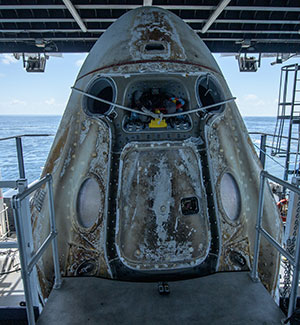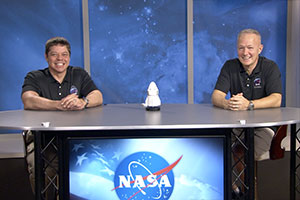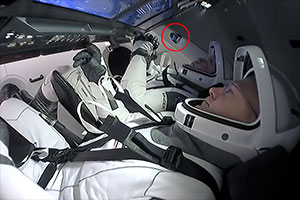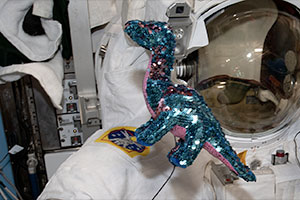August 5, 2020 — The first U.S. commercial spacecraft to launch astronauts into Earth orbit and then return them home safely could land in the Smithsonian — but not yet, said its history-making crew.
NASA astronauts Bob Behnken and Doug Hurley reflected on the legacy, and future, of their SpaceX Crew Dragon capsule just two days after splashing down on board the privately-owned and operated spacecraft in the Gulf of Mexico.
Hailed by the head of NASA as beginning a new era of U.S. human spaceflight, Behnken and Hurley's two-month-long Demo-2 mission made the "good ship Endeavour" more than worthy of a National Air and Space Museum display, were the spacecraft not already slated to fly again to the International Space Station.
"I still think there's an opportunity for the history to play out and this capsule to still end up in the Smithsonian," Behnken said in a post-flight press conference on Tuesday (Aug. 4) at NASA's Johnson Space Center in Houston. "It can be used and reused, and then find that permanent home."
Likewise, another highly-visible — and colorfully-sequined — mission artifact could someday be museum-bound, pending the desires of its young owners.
SpaceX on exhibit
Unlike all of the previous U.S. crewed capsules, which completed one spaceflight each and then were retired to museums, the Demo-2 Crew Dragon "Endeavour" will be inspected, serviced and prepared to launch again. The historic spacecraft's next mission will be Crew-2, SpaceX's second operational flight with NASA crew members, including Behnken's wife, astronaut Megan McArthur.
"If it was up to me, I think all of this hardware would have a home some place in the future, when it is used up. It's just not used up yet," Behnken said, responding to a question from collectSPACE.
Behnken cited SpaceX's decision to exhibit the retired first stages from its Falcon 9 rocket — the same type of launch vehicle that he and Hurley rode — in Houston and at its headquarters in Hawthorne, California, as an example of the company's interest in sharing its artifacts with the public.
"SpaceX has done a wonderful job, if you have ever visited or seen pictures inside the facility in Hawthorne. They do have hardware that they have flown or hardware that they have tested and managed to put on public display," he said.
"And it's just awesome for people to see that hardware and be able to recognize it as hardware that we use for space missions and take a picture next to it and be a part of it," said Behnken.
If his spacecraft does go on display, Behnken hopes that two things from Demo-2 remain attached.
"We did leave a [mission] patch inside the vehicle," he said. "There is a Demo [2] sticker that we added [to the wall], and we did give the ship a name, 'Endeavour.' I am hopeful that they will be able to keep both of those things as they go forward."
Flown 'fossil'
If Endeavour is the most obvious artifact from the Demo-2 mission to someday be found in a museum, then "Tremor" might be the most in demand.
A small, sequined apatosaurus dinosaur, Tremor was chosen by 6-year-old Theo Behnken and 10-year-old Jack Hurley to serve as their fathers' "zero-g indicator." From the moment the public caught sight of it floating weightless, the toy's sales skyrocketed on Earth.
"I think there are a lot of Tremors out there at this point," said Behnken. "It could be that the marketplace is saturated with Tremors."
Because the dinosaur was flown for both of their sons, a custody agreement is in the works, said Hurley.
"I think we are probably going to go along the lines of the NHL [National Hockey League, and] the team that wins the Stanley Cup. If you're familiar with that, each member of the team gets to have the Stanley Cup for a day or two. I think we'll probably work out something along those lines, where he spends some time at Bob's place and then spends some time at our place," said Hurley. "I think that's fair."
"Then, at some point, the boys will grow up and potentially outgrow Tremor, so we'll figure out a good place for Tremor, just like hopefully with Endeavour and our [space] suits and anything else that was associated with this mission," he said.
Still, the Smithsonian (or other museum) might need to sweeten the deal before landing the dinosaur.
"They might make that agreement, but I'm sure they would request something in trade," Behnken said of the two boys, with a laugh. "I don't know ... at least an opportunity to go see where Tremor's new home would actually be." |
|

The SpaceX Crew Dragon "Endeavour," that flew with astronauts Bob Behnken and Doug Hurley, is positioned on the SpaceX GO Navigator recovery ship after splashing down in the Gulf of Mexico on Sunday, Aug. 2, 2020. The spacecraft is destined to fly again, but could land in the Smithsonian, someday. (NASA/Bill Ingalls)

NASA astronauts Bob Behnken and Doug Hurley discuss their SpaceX Demo-2 mission and successful return inside their Crew Dragon spacecraft Endeavour during their first post-flight press conference, Aug. 4, 2020 at Johnson Space Center. (NASA TV)

Doug Hurley (in foreground) and Bob Behnken added a Demo-2 mission patch decal (circled in red) to an interior wall aboard the SpaceX Crew Dragon Endeavour, with the hope it will remain with the spacecraft going forward. (NASA TV)

"Tremor," the Demo-2 dinosaur, was chosen by Doug Hurley's and Bob Behnken's sons as the mission's "zero-g indicator." (NASA) |
